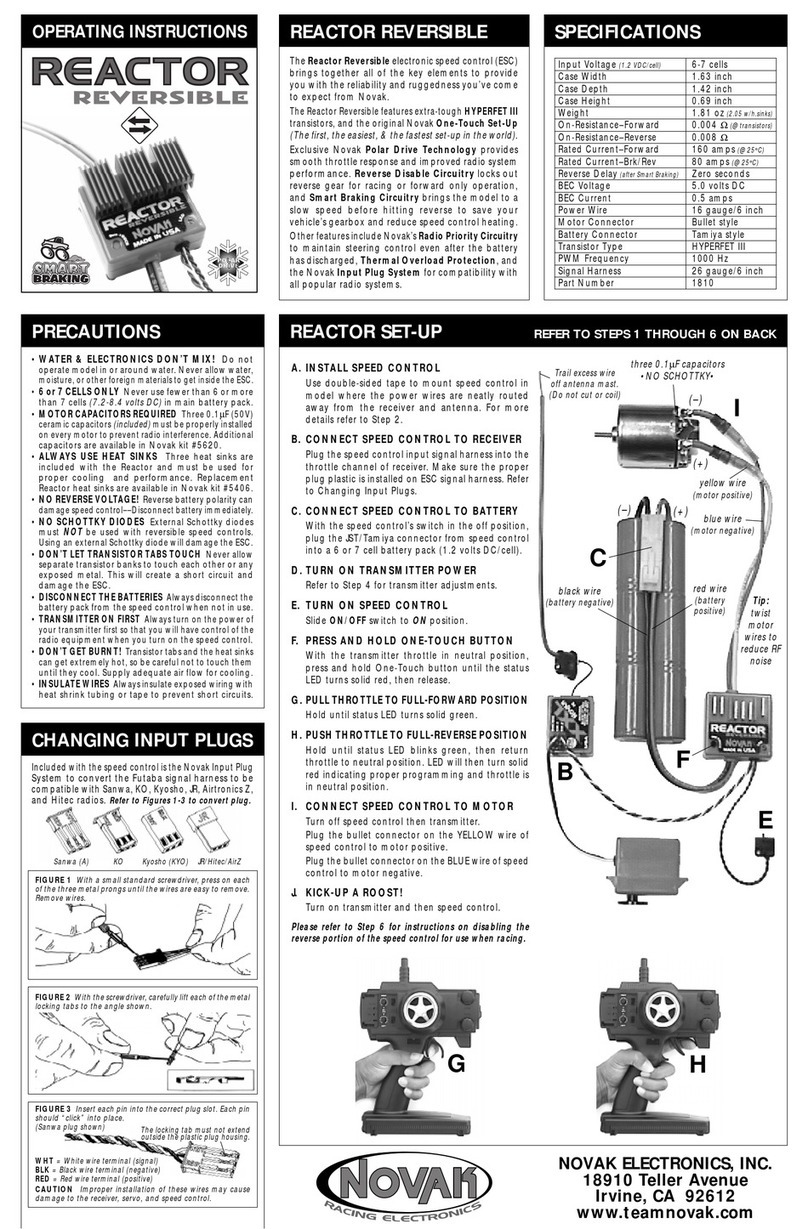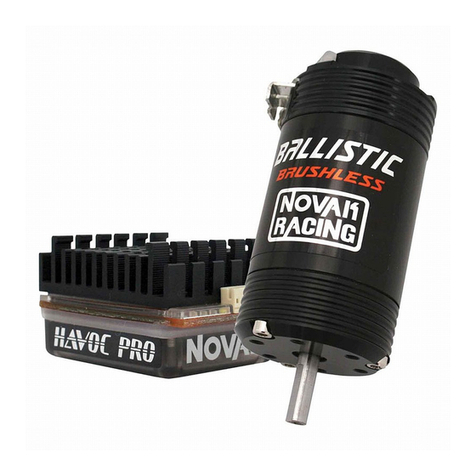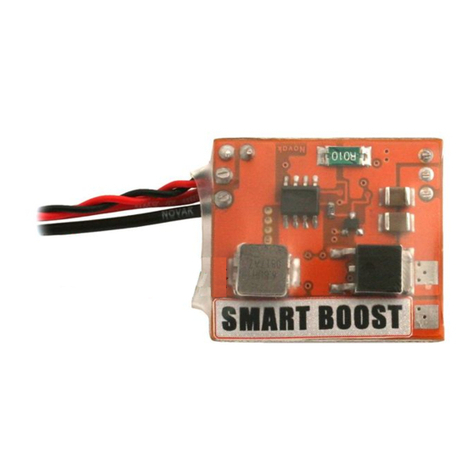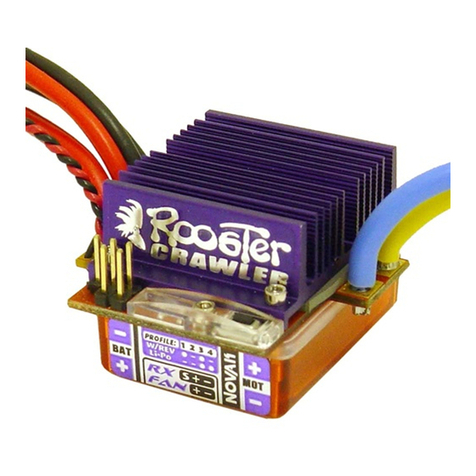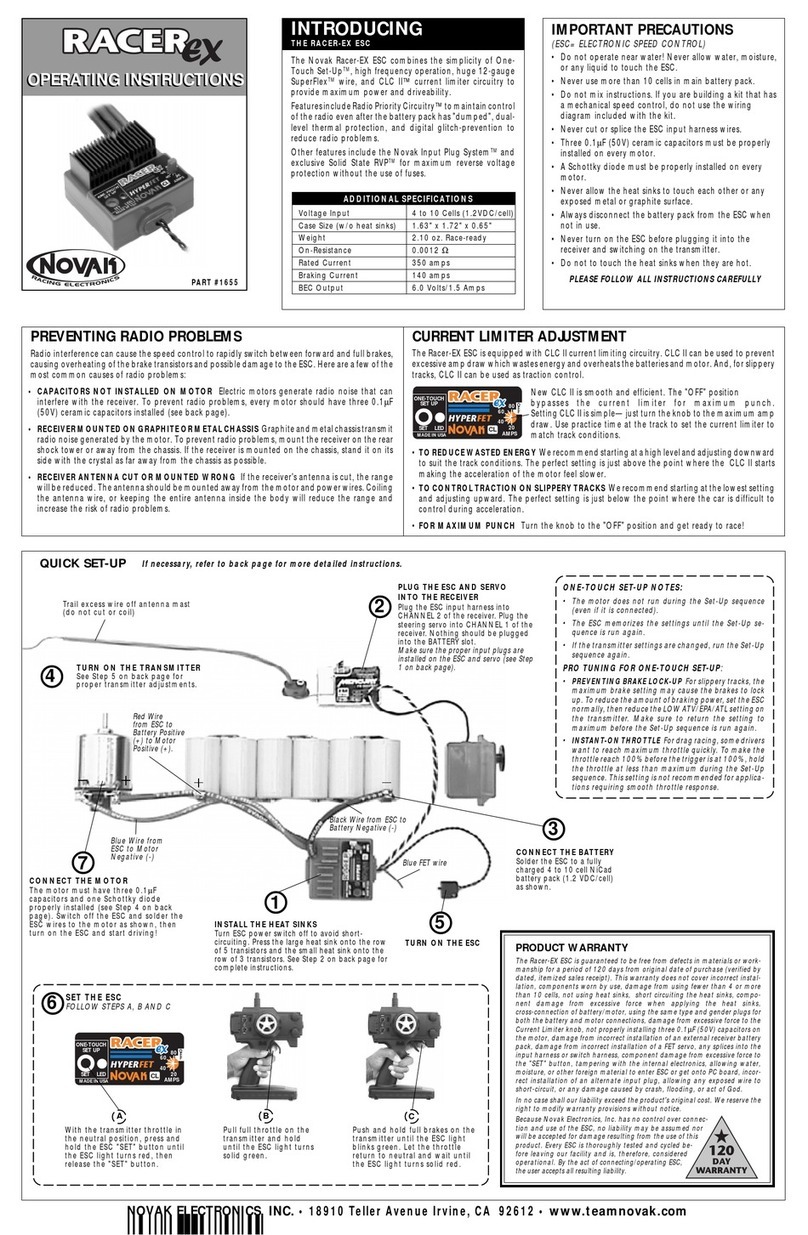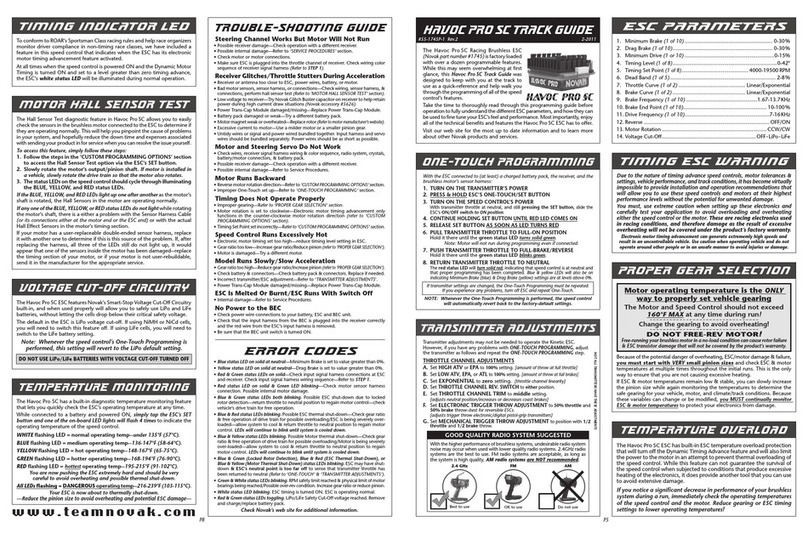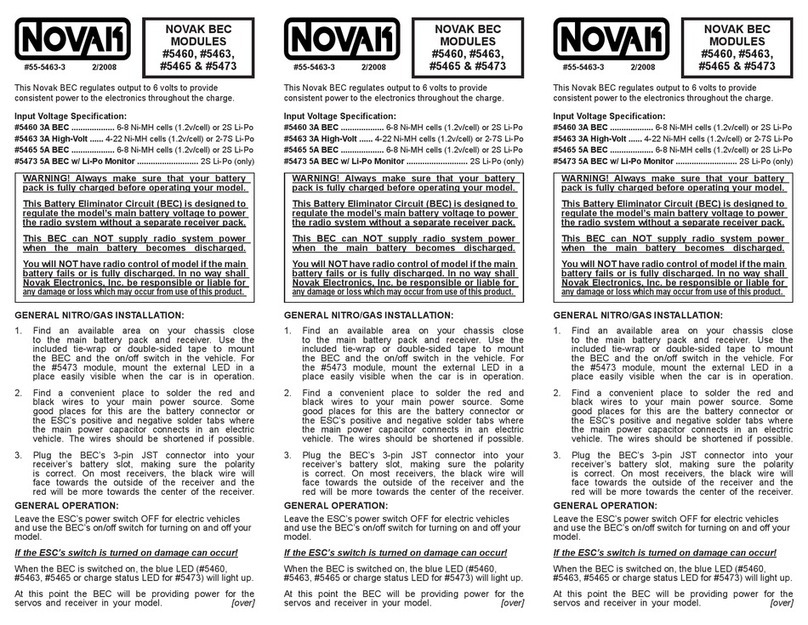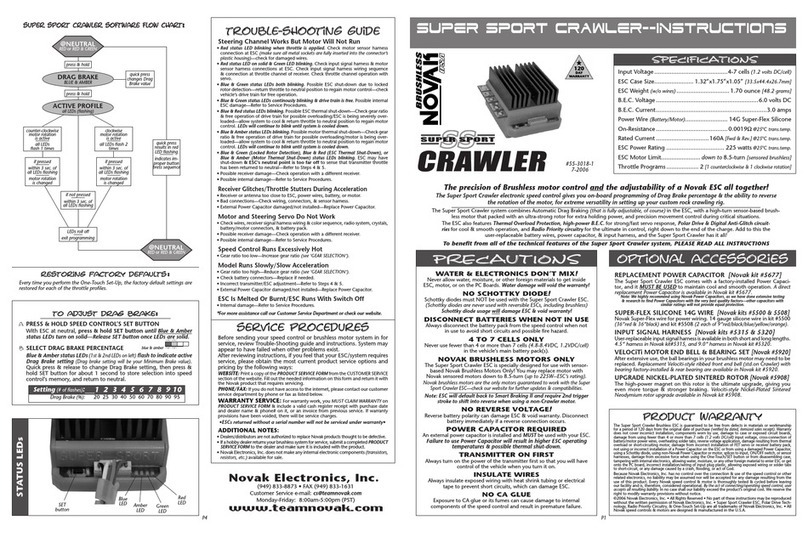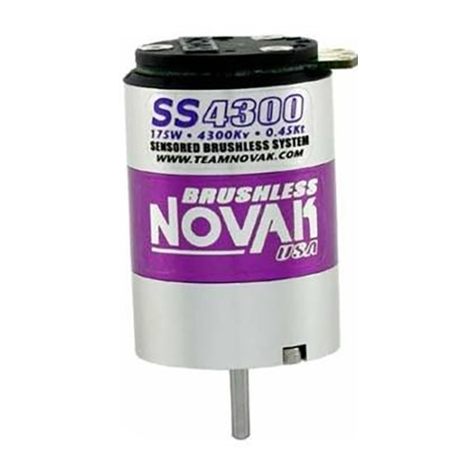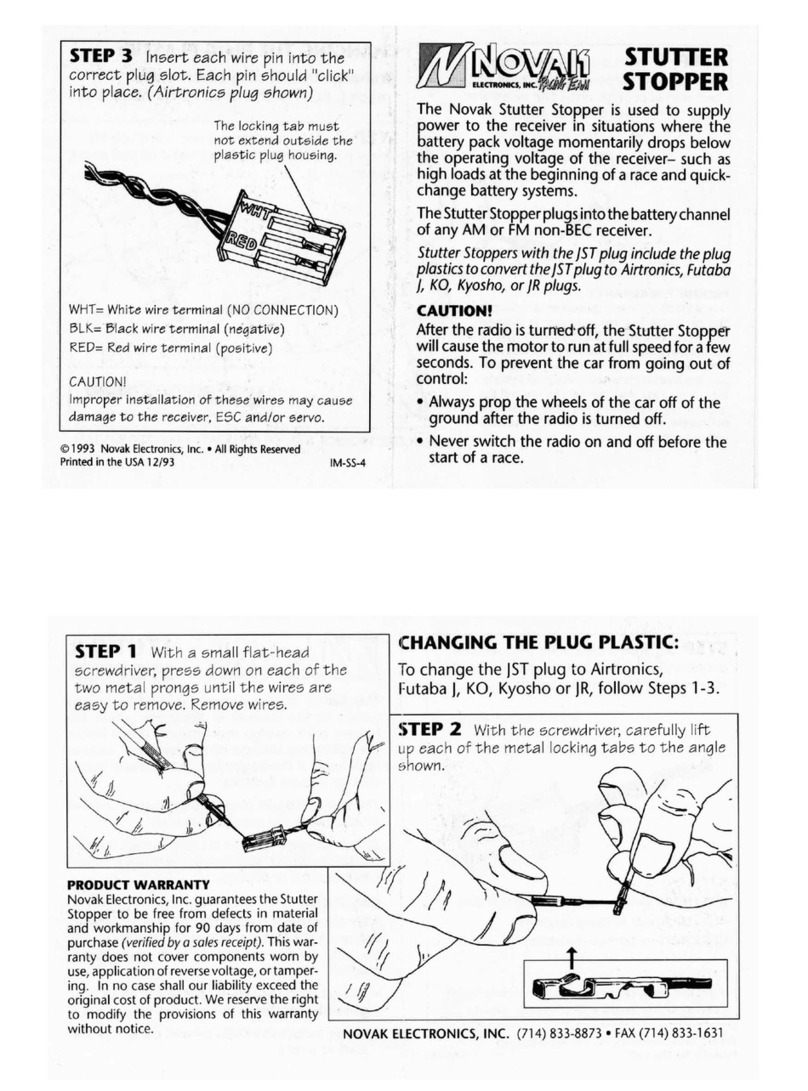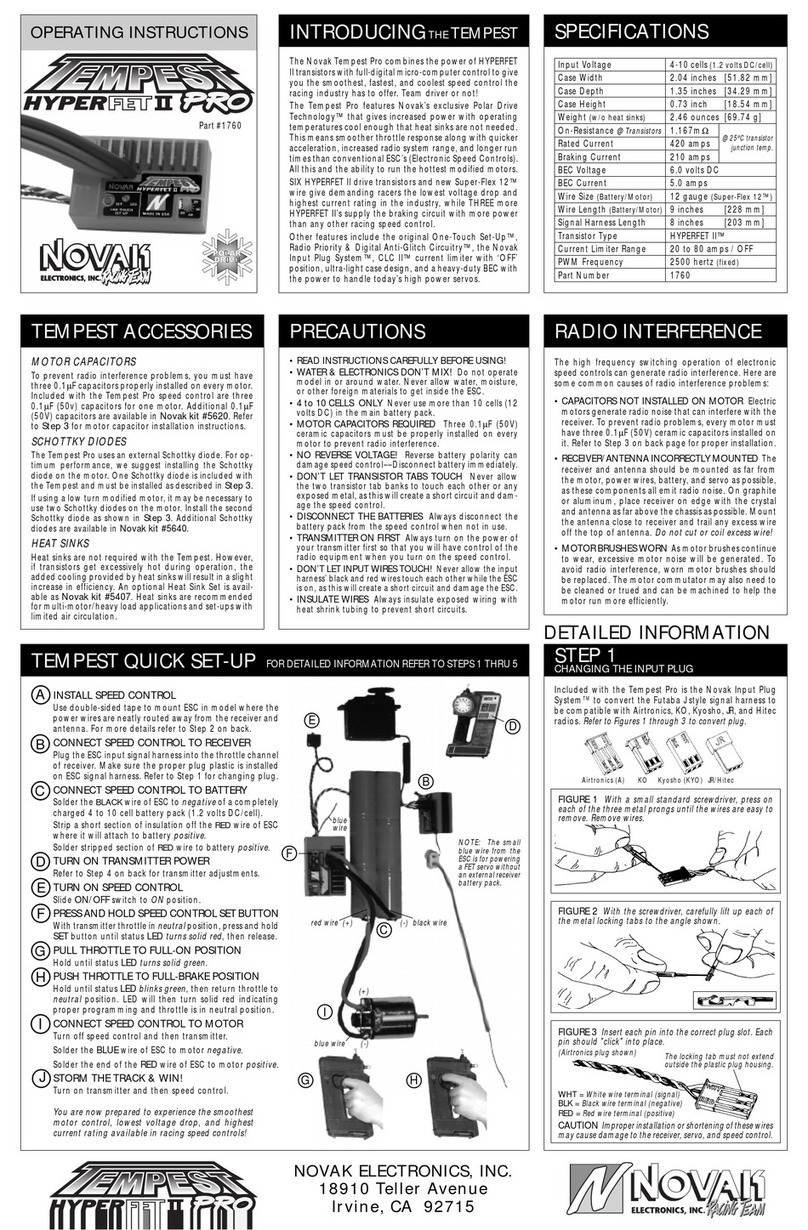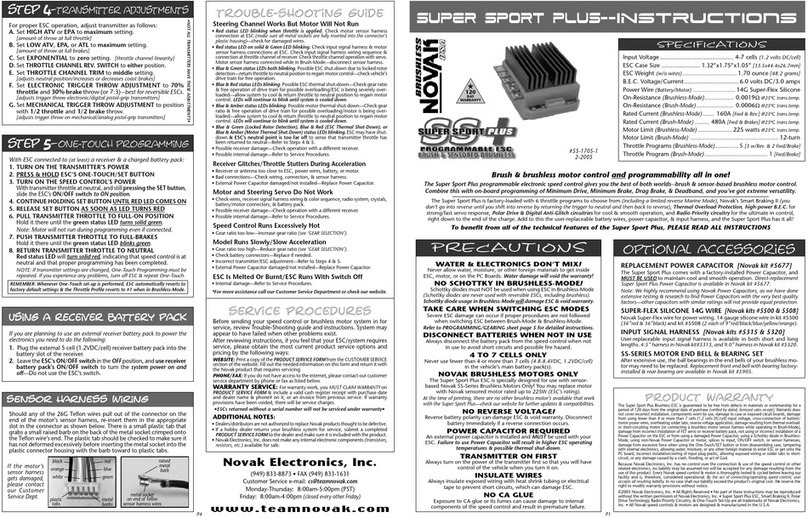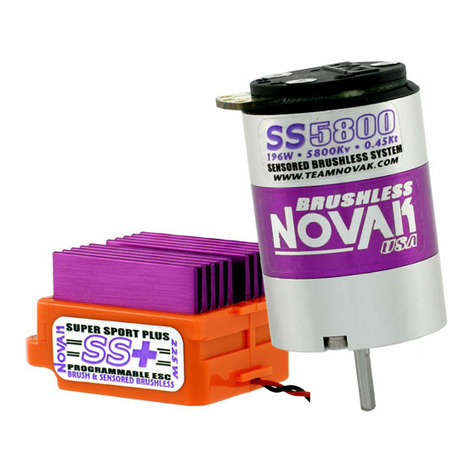#55-1840-1
1-2007
SPECIFICATIONS
Input Voltage.................... 4-7 cells
(@1.2 volts DC/cell)
/ 2 Li-Po cells
Li-Po Cut-Off Voltage ...............................................6.25 volts DC
ESC Footprint............................................
1.18” x 1.54” [30x39mm]
ESC Weight
(w/o wires)
................................. 1.57 ounce
[44.5 grams]
B.E.C. Rating............................................ 6.0 volts DC / 1.5 amps
Power Wire
(Battery/Motor)
.......................... 14G Super-Flex Silicone
Rated Current ...................... 400A Fwd / 200A Rev
@25°C trans.temp.
On-Resistance ........... 0.0014ΩFwd / 0.0028ΩRev
@25°C trans.temp.
Motor Limit ................... 12-turn
[brush-type motor @ 6 cells (1.2VDC/cell)]
Throttle Profiles............................... 4
[2 fwd/brk/rev & 2 w/rev.lock out]
Switched Fan Output.................................................6.0 volts DC
The Rooster Reversible is back, and is better than ever!
The Rooster
12T reversible electronic speed control brings you rugged 12-turn motor handling, built-in
Smart-Stop Li-Po Cut-Off circuitry, and all the performance you’ve come to expect from Novak.
The ESC also features Thermal Overload Protection, high-power B.E.C. for strong/fast servo response, Polar Drive & Digital
Anti-Glitch circuitries for cool & smooth operation, and Radio Priority circuitry for the ultimate in control, right down to the
end of the charge. Add to this the user-replaceable power wires, power capacitor, & input harness, along with power output
for auxiliary cooling fans that turn on & off with the ESC’s power switch, and the new Rooster
12T has it all!
To benefit from all of the technical features of the Rooster
12T, PLEASE READ ALL INSTRUCTIONS
REPLACEMENT POWER CAPACITOR [Novak kit #5677]
The Rooster
12T ESC comes with a factory-installed Power Capacitor
, and it
MUST BE USED
to maintain cool and smooth operation. A direct replacement
Power Capacitor is available in Novak kit #5677.
Note: We highly recommend using Novak Power Capacitors, as we have done extensive testing
& research to find Power Capacitors with the very best quality factors––other capacitors with
similar ratings will not provide equal protection.
SUPER-FLEX SILICONE 14G WIRE
[Novak kits #5500 & 5505]
Novak Super-Flex wire for power wiring. 14 gauge silicone wire in kit #5500
(36”red & 36”black)
and kit #5505
(36”red & 36”blue)
.
INPUT SIGNAL HARNESS [Novak kits #5315 & 5320]
User-replaceable input signal harness is available in both short and long lengths.
4.5” harness in Novak kit#5315, and 9.0” harness in Novak kit #5320.
MOTOR CAPACITORS
[Novak kit #5620]
Additional motor capacitors are available in Novak kit #5620.
AUXILIARY COOLING FANS [Novak kits #5647 & #5648]
The Rooster 12T comes with power output pins ready to add a cooling fan
that will switch on & off with the ESC’s power switch.
Novak 25x25x10mm fan with long leads for cooling motor is available in Novak
kit #5647. Novak 30x30x6mm clear fan that fits perfect over the ESC’s heat sink
and has a connector already on its leads is available in Novak kit #5648.
WATER & ELECTRONICS DON’T MIX!
Never allow water, moisture, or other foreign materials to get inside
ESC, motor, or on the PC Boards. Water damage will void the warranty!
NO SCHOTTKY DIODE!
Schottky diodes must NOT be used with the Rooster ESC.
(Schottky diodes are never used with reversible ESCs, including brushless)
Schottky diode usage will damage ESC & void warranty!
DISCONNECT BATTERIES WHEN NOT IN USE
Always disconnect the battery pack from the speed control when not
in use to avoid short circuits and possible fire hazard.
4 TO 7 CELLS OR 2-CELL Li-Po ONLY
If using Ni-Cd or Ni-MH batteries, NEVER use fewer than 4 or more
than 7 cells
(4.8-8.4VDC, 1.2VDC/cell)
in the vehicle’s main battery pack.
If using Li-Po batteries, ONLY use a 2-cell pack for the vehicle’s main
battery & be sure to use Profile 3 or 4 with the built-in Li-Po cut-off.
NO REVERSE VOLTAGE!
Reverse battery polarity can damage ESC & void warranty. Disconnect
battery immediately if a reverse connection occurs.
POWER CAPACITOR REQUIRED
An external power capacitor is installed and MUST be used with your ESC.
Failure to use Power Capacitor will result in higher ESC operating
temperatures & possible thermal shut-down.
TRANSMITTER ON FIRST
Always turn on the power of the transmitter first so that you will
have control of the vehicle when you turn it on.
INSULATE WIRES
Always insulate exposed wiring with heat shrink tubing or electrical
tape to prevent short circuits, which can damage ESC.
NO SOLVENTS
Exposing the speed control’s case to any type of
solvents will damage the plastic.
NO CA GLUE
Exposure to CA glue or its fumes can cause damage to internal
components of the speed control and result in premature failure.
trouble-shooting guide
Steering Channel Works But Motor Will Not Run
• Red LED flashing: Speed control has thermally shut down––Allow ESC to
cool down––Use milder motor or smaller pinion gear––Check for adequate
cooling to ESC’s heat sink.
• Red & Green LEDs alternately flashing: Smart-Stop Li-Po circuitry has shut
off throttle output––Use a charged Li-Po battery. Using Ni-Cd or Ni-MH
batteries with ESC in Profile 3 or 4––change battery type or ESC Profile.
• Check motor connections. Check motor and brushes
.
• Make sure ESC is plugged into the throttle channel of receiver. Check
wiring color sequence of receiver signal harness (Refer to Step 1)
.
• Possible receiver damage––Check operation with a different receiver.
• Possible internal damage––Refer to Service Procedures.
Receiver Glitches/Throttle Stutters During Acceleration
• Receiver or antenna too close to ESC, power wires, battery, or motor.
• Bad connections––Check wiring, connectors, & sensor harness.
• Motor capacitors broken or missing––Refer to Step 3.
• Excessive current to motor––Use a milder motor or a smaller pinion gear.
• External Power Capacitor damaged/not installed––Replace Capacitor.
Motor and Steering Servo Do Not Work
• Check wires, receiver signal harness wiring & color sequence, radio system,
crystals, battery/motor connectors, & battery pack.
• Possible receiver damage––Check operation with a different receiver.
• Possible internal damage––Refer to Service Procedures.
Speed Control Runs Excessively Hot
• Gear ratio too low––Increase gear ratio.
Model Runs Slowly/Slow Acceleration
• Gear ratio too high––Reduce gear ratio.
• Check battery connectors––Replace if needed.
• Incorrect ESC/transmitter adjustment––Refer to Step 4 & Transmitter
Adjustments sections.
• External Power Capacitor damaged/not installed––Replace Power Capacitor.
Motor Runs Backwards
• Motor wired backwards––Check wiring and reverse.
• Backwards motor timing––Reverse motor end bell.
ESC Is Melted Or Burnt/ESC Runs With Switch Off
• Internal damage––Refer to Service Procedures.
*For more assistance call our Customer Service Department or check our website.
service procedures
Before sending your speed control in for service, please review the
Trouble-Shooting guide and instructions. Speed control may appear
to have failed when other problems exist.
After reviewing instructions, if you feel that your ESC requires service,
please obtain the most current product service options and pricing
by the following ways:
WEBSITE: Print a copy of the PRODUCT SERVICE FORM from the
CUSTOMER SERVICE section of the Novak website. Fill out the needed
information on this form and return it with the Novak product that
requires servicing.
PHONE/FAX: If you do not have access to the internet, please contact
our customer service department by phone or fax as listed below.
WARRANTY SERVICE: For warranty service, you MUST CLAIM
WARRANTY on the PRODUCT SERVICE FORM and include a valid cash
register receipt with purchase date and dealer name & phone# on it,
or an invoice from previous service. If warranty provisions have been
voided, there will be service charges.
•ESCs returned without a serial number will not be serviced under warranty•
ADDITIONAL NOTES:
• Dealers/distributors are not authorized to replace Novak products
thought to be defective.
• If a hobby dealer returns your product for service, submit a completed
PRODUCT SERVICE FORM to the dealer and make sure it is included
with the product.
• Novak Electronics, Inc. does not make any internal electronic
components (transistors, resistors, etc.) available for sale.
roOster 12T--
INstructIons
PRECAuTIONS
optional accessories
P1P4
product warranty
The Rooster
12T ESC is guaranteed to be free from defects in materials or workmanship for a period of 120 days
from the original date of purchase (verified by dated, itemized sales receipt). Warranty does not cover incorrect
installation, components worn by use, damage to case or exposed circuit boards, damage from using fewer than
4 or more than 7 Ni-Cd or Ni-MH cells (1.2 volts DC/cell) or fewer or more than 2 Li-Po cells input voltage, cross-
connection of battery/
motor power wires, overheating solder tabs, reverse voltage application, damage resulting
from thermal overload
, damage from incorrect installation of FET servo or receiver battery pack, not using or
incorrect installation of a Power Capacitor on ESC or from using a damaged Power Capacitor, using a Schottky
diode, using non-Novak Power Capacitor, splices to input or ON/OFF switch harnesses, damage from excessive
force when using the One-Touch/SET button or from disassembling case, tampering with internal electronics,
allowing water, moisture, or any other foreign material to enter ESC or get onto the PC board, incorrect instal-
lation/wiring of motor/battery connectors, input plug plastic, or auxilliary cooling fan, allowing exposed wiring,
pins, or solder tabs to short-circuit, or any damage caused by a crash, flooding, or act of God.
Because Novak Electronics, Inc. has no control over the connection & use of the speed control or other
related electronics, no liability may be assumed nor will be accepted for any damage resulting from the
use of this product, including battery packs. Every Novak speed control & motor is thoroughly tested &
cycled before leaving our facility and is, therefore, considered operational. By the act of connecting/operating
speed control, user accepts all resulting liability. In no case shall our liability exceed the product’s original
cost. We reserve the right to modify warranty provisions without notice.
©2007 Novak Electronics, Inc. • All Rights Reserved • No part of these instructions may be reproduced
without the written permission of Novak Electronics, Inc. • Rooster
12T ESC, Polar Drive Technology,
Radio Priority Circuitry, & One-Touch Set-Up are all trademarks of Novak Electronics, Inc. • All Novak
speed controls are designed & manufactured in the U.S.A., and are lead-free & RoHS compliant.
Li-PO cUt-off ciRCUitRY
AuXilliARy Fan connection
Your Rooster 12T reversible speed control is Novak’s first ESC with built-in
Smart-Stop Li-Po Cut-Off Circuitry for safe, worry-free operation when
using Lithium Polymer batteries. When the speed control is in Profile 3
or Profile 4, the Smart-Stop Li-Po Cut-Off circuitry is active.
The Smart-Stop Cut-Off circuitry constantly monitors the Li-Po battery’s
pack voltage. When the pack’s voltage begins to get close to the critical
safety voltage, the Cut-Off circuitry will start interrupting, or ‘blipping’
the throttle output. This ‘blipping’ acts as an early warning to you that
the battery voltage is getting low, and that the throttle output to the
motor will soon be completely shut off.
When the battery pack’s critical safety voltage is finally reached, the
Smart-Stop Cut-Off circuitry will completely shut down the throttle
output signal to the motor to keep the battery voltage from dropping
further
(Red & Green LEDs will alternately flash--you will still have steering control).
Re-
charge battery pack after Smart-Stop circuitry shuts off throttle.
After a short resting period, the battery’s voltage will rise back above
the critical safety voltage, and the ESC will operate normally again for a
short period of time. This is not good for the battery pack, as reaching
the critical safety voltage too many times can also cause damage to the
cells. DO NOT CONTINUE TO RUN VEHICLE AFTER THE SMART-STOP
HAS SHUT DOWN THE THROTTLE OUTPUT FOR THE FIRST TIME.
If Profile 3 or Profile 4 is used with Ni-Cd or Ni-MH type batteries, the
cut-off circuitry will shut off the speed control’s throttle output very early
into the battery pack’s runtime, due to the different characteristics of
these batteries––Change ESC’s Throttle Profile to Profile 1 or Profile 2
for use with these batteries.
The Rooster 12T reversible speed control also features a set of power
output pins for running auxiliary cooling fans. This allows you to add
cooling fans to either the motor, the speed control, or both, and the
best part is that they will automatically switch off when you turn off
the speed control’s power switch.
These pins output 6.0 volts DC (the same as the BEC), so you will get
maximum output from your cooling fans.
The Rooster’s pin-out label located on the front lower section of the
ESC’s case
(under the pins, push button, & LEDs)
shows the location and the
polarity of the fan power output pins. They are the 2 pins on the front
edge of the circuit board--Positive (+) is on the left, and Negative (–) is
on the right. The set of 3 pins behind them are for the user-replaceable input
signal harness, and the polarity of those is the same--Positive in the middle,
Negative on the right, and the extra pin on the left is signal.
The Novak 30x30x6mm clear cooling fan that comes on the GTB speed
control (Novak kit #5648) not only fits the size of the Rooster’s heat sink
perfectly, it also comes with the connector already on it for directly
plugging in. Fans that do not have the proper connector on them,
will need a connector
(one end of an old receiver input harness would work
well)
, or will need to be soldered to the pins--Take extra care if attempting
to solder to the fan power output pins--Do not overheat the pins or the
circuit board, and do not allow any solder or wire strands to cause a
short circuit with other pins or the heat sink.
Novak Electronics, Inc.
(949) 833-8873 • FAX (949) 833-1631
Monday-Friday: 8:00am-5:00pm (PST)
pin-out label
positive
fan pin
negative
fan pin
www.teamnovak.com



